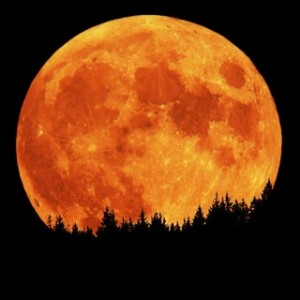
“Would that thou couldst last for aye,
Merry, ever-merry May!”
William D. Gallagher (the forgotten Ohio poet)
BURNED-OVER DISTRICT, NY–The clouds of April have scattered, so look skyward (while keeping your feet on the ground). Herewith, from the essential First Principles Journal, the story of another Ohioan who did just that:
The moon’s mild ray has e’er bewitched me, but ne’er was a man more poorly suited to a life of science. Carbon, ions, gametes, the Doppler Effect: I can’t think of a single chemical or physical phenomenon that I have ever really understood.
Yet we are often drawn to things we can’t possibly comprehend, aren’t we? I love to sit out back of a summer’s eve, libation in hand, and watch the moon trace its slow and steady arc across the zodiac. I could not care less that a handful of government employees have bounded along its surface, and I abhor the thought that the American (or any other) Empire may one day deface our natural satellite with a military base. The moon, like the haggard ex-looker in the Raymond Chandler novel, is best seen at a distance.
So too believed Leslie Peltier (1900-1980) of Delphos, Ohio, whom Harvard College Observatory director Harlow Shapley called “the world’s greatest non-professional astronomer.” Peltier’s memoir Starlight Nights (1965) is quite simply the best book ever written on the romance of the night sky, and how apt that the foreword to its latest paperback incarnation is by David H. Levy, a worthy heir to the great Peltier.
I had the pleasure five years ago of spending an April twilight interviewing Levy, the foremost comet-hunter of our age (he has twenty-two to his credit) at his home-based Jarnac Observatory in Vail, Arizona. After our chat we looked at Venus, Jupiter, and Saturn. This was like shooting baskets with Michael Jordan, trading obscene limericks with Jason Peters, or drinking with my friends the Sheehans. You don’t belong on the same court (or bar) with ‘em, but you’re sure happy to be there.
Among Levy’s books are a volume on astronomical poetry (More Things in Heaven and Earth/1997) and a fine biography of another small-town astronomer, Clyde Tombaugh of Burdett, Kansas, who discovered Pluto in 1930 at the Lowell Observatory in Flagstaff, that redoubt of poetical eccentricity and wide-eyed wonder endowed by the Brahmin Percival Lowell, who saw canals on Mars (and who am I to say he didn’t?).
Leslie Peltier had no such illusions, but then he didn’t need to conjure up superlunary utopias. He was, writes Levy, a “shy and retiring man who loved his Delphos, Ohio, home so much that he rarely left it.”
Starlight Nights is as much about Peltier’s life on Ohio ground as it is about his explorations of Ohio skies. “Blessed are those who are raised on a farm,” is Peltier’s addition to the Beatitudes. His family farm consisted of fifty acres of corn, wheat, oats, and clover, an orchard of fruit trees, and a few cows which young Leslie kept half an eye on whilst swimming in the Auglaize River, memorizing “Thanatopsis,” playing his fife, and hunting English sparrows with his air rifle (“A plague on all these foreign imports!”). His room in the Peltier farmhouse was the outdoors brought inside, adorned with his collections of butterflies, Indian arrowheads, insects, and rocks. The social life of Delphos was defined by “Granges, Ladies Aids and country churches,” though its economy, unhappily, was later distorted by “price supports, allotments, and controls.”
At age fifteen a question occurred to Leslie that has occurred to many others who have looked upward into the night sky: “Why do I not know a single one of those stars?” A wise librarian in Delphos gave the curious boy Martha Evans Martin’s The Friendly Stars, and within the year he had come to know Vega, Deneb, Antares, Capella, and the other stellar lights. Leslie Peltier was a classic American autodidact. He dropped out of high school to work on the family farm when his older brother went off to Europe to make the world safe for democracy, and Leslie never did return to school, for “life on the farm was so pleasant, so independent and so complete that I had no desire to give it up.”
With eighteen dollars hard-earned from picking strawberries, Leslie purchased a little mail-order telescope for which he rigged up a mounting, the first in his series of do-it-yourself telescopic exhibitions of Buckeye ingenuity. A 4-inch scope soon followed. As a teenager he began recording his observations of variable stars, compiled in the cow pasture in which he set up the instrument, his skywatching scored by crickets, owls, and bullfrogs. “Cows are friendly folk and have a great sense of curiosity,” learned Peltier. “They often would come over and keep me company during my long hours at the telescope…slowly chewing their cuds and watching me thoughtfully with their big soft eyes.”
Frost and dew and chill winds were among the inconveniences kept at bay when Leslie and his dad built an observatory (which the neighbors mistook for a chicken house), though he regretted that “I now had lost my common touch with all the other denizens of the night”—the fireflies, the chirping insects, and, to his sorrow, “my gallery of cows [which] deserted me completely.”
This self-taught farmboy who sent in meticulous variable-star observations and wrote searching letters to famous astronomers was becoming known far beyond Delphos. The director of the Princeton Observatory sent him a 6-inch refractor telescope, with which Leslie would seek out comets, emboldened by a passage in the Beginner’s Star Book: “There is no weighty reason why any amateur astronomer should not be the discoverer of a comet. The requisites are a telescope of low power, large field, and generous illumination; a good store of pertinacity and patience, and a fair knowledge of the constellations.”
Three years of hunting later, on Friday November 13, 1925, Leslie Peltier, by now a stock clerk in a truck factory, finished his evening chores on the farm, bundled up in a heavy mackinaw, wool cap, and sheepskin gloves, and walked out to his observatory. While sweeping the sky he found a “small round fuzzy something” at the northern end of the constellation Bootes.
“Had I found a new comet or was it only new to me?” he wondered, if one can be said to wonder frantically. “Had I merely stumbled onto one that might have been spotted somewhere weeks before?”
Calming himself, Leslie “knew that I must make absolutely certain of everything and then get off a wire to Harvard College Observatory.” He plotted its location, estimated its brightness and rate of motion, prepared a telegraphic message—NINTH MAGNITUDE COMET ONE FIVE TWO FIVE NORTH FORTY FOUR DEGREES RAPID MOTION SOUTH—and ran to the house to call Western Union. The office was closed. The operator informed Leslie that emergency telegrams could be sent from the signal tower at the railway depot, but it had no telephone connection. He would have to drive. Alas, his parents had the car and were out for the evening. So he took his old bicycle out of the garage, and raced several miles through a Delphic darkness, his only company the occasional barking of farm dogs. Finally he reached the tower, climbed its wooden steps, gave his message to the befuddled telegrapher (“This some sorta code?” “Sorta”) and pedaled home, alternately exuberant with the thrill of discovery and fearful that the haughty Harvardian who received his message would mock him (“I say, here’s a good one, some chap out in Ohio has just found that comet that was reported about six weeks ago!”).
A week later, the town druggist called to read a telegram from Harvard confirming the discovery. With a pride so movingly conveyed that only an automaton will not feel his heart swell, Leslie carved “Peltier 1925” into the mahogany tube of his comet-seeker. There would be eleven more comets over the years. How much more inspiriting this achievement is than that of a later small-town Ohio boy, Neil Armstrong, who took a multibillion-dollar joyride to the moon.
Leslie Peltier didn’t need taxpayer alms. I like his account of life during the Depression: “[O]nce again I became a full-time farmer…Here on the farm life went on, basically, much as before. Turtlelike, we simply withdrew a bit into the shelter of our shell and waited.” Their waiting should not be mistaken for torpor. Leslie and his doughty wife Dottie swam in the river, hiked, hunted fossils, cooked over a campfire, and watched the stars, which neither poverty nor tyranny could blot from the empyrean.
Starlight Nights limns a life spent among the stars, or “wandering aimlessly about the moon,” yet Peltier’s feet are always planted in Ohio earth. His love of Delphos is honest and generous. He does not approve of all he sees (as when, for instance, during the hysteria of World War One “some of the town’s respected citizens caught the vigilante virus and forced their bewildered [German] neighbors to publicly kiss the flag.”) Over the years Peltier and his observatory hosted thousands of schoolchildren. He and Dottie were “variously involved in church affairs, in Eastern Star, in garden clubs, and in a devious maze of Cub Scout work.” They were citizens of their place, ordinary yet extraordinary, as famous astronomers made pilgrimages to Delphos to meet its resident high-school dropout with his Argus eye on the sky.
Like Thoreau, Leslie Peltier traveled widely in his own backyard. One of his few ventures outside Delphos was a charmingly described honeymoon trip he and Dottie took in the Southwest, camping their way across America while hunting gravestone epitaphs and rare minerals and spelunking in “old Indian caves.” As a patriot of a place, he did not disdain other places: he loved them not in spite of their differences but because they were different, all part of this beautifully variegated world of which he and Delphos were a vital part.
A later Peltier book, The Place on Jennings Creek (1977), which I have never been able to lay eyes on, is said to be a rich account of the natural world, the flora and fauna, of his Delphos home. Leslie and Dottie finally bought their own home in 1948, the “old Moennig place” at the western end of town. “We made few changes and even those few were mostly in retrograde motion. What we found here was sound and good. It was a leftover bit of an earlier America and we had no desire to bring it up to date.” He did, of course, move his observatory onto the grounds.
Peltier was unmoved by the glories of the sky when mediated by any technology much beyond two pieces of glass at either end of a tube. “No photograph has yet been made which is not cold and flat and dead when compared with the scenes that meet one’s eyes when the moon is viewed through even a small telescope,” he wrote.
The telescope, he stated “most emphatically,” is “not essential to an enjoyment of the stars.” Just stand ‘neath the sky and gaze upward into the firmament. The enchantment, said Peltier, is the same. Without a scope, he concluded, “life for me would change but little. Telescope or not, I would still keep watch.” (He did bemoan the artificial satellites traversing the sky: “mankind’s latest pollution in the name of progress.”)
Leslie Peltier, as a man firmly placed in Delphos, opposed the “conquest of the moon.” The space program he regarded as just another act of “greedy pillage.”
“I know that someday man will reach the moon but I sincerely hope this will not happen for a long, long time. He has a lot of growing up to do before he will be ready for the moon…If man must meet a challenge he can find one here on earth. If he must conquer something let it be himself.”
Night falls in my town somewhere east of Delphos, and I haul my eight-inch Dobsonian reflector out beyond the raspberry patch in our backyard. I bought the telescope several years ago when I finally received a payment I had long before given up on. I couldn’t dust Leslie Peltier’s eyepiece but that doesn’t matter: the moon is there for me, too, rising over the hedgerow.
Leslie Peltier was right. The moon is just fine where it is. Leave it alone. Everything in its place, don’t you know?




8 comments
Mike Grone
Your local public library should be able to borrow copies of Peltier’s books for you to read. I read the US Navel Observatory’s copy of “The Place on Jennings Creek”.
Mike Grone
Happily, the Peltier home was purchased several years ago and restoration commenced.
Jim
I was enchanted by the book when I read it 1990. So enchanted, that upon leaving the Navy in the following months and realizing that I could divert my return home, I stopped in to Delphos to investigate. The local fire station provided me with directions to his place. Of course, no one was home (I didn’t know he died). A friendly neighbor that was taking care of the grounds let me poke around. His merry-go-round was still there, sans telescope, of course. The 12 inch Clark in the large observatory was still there, sans lens, thankfully. The observatory had fallen into disrepair and was open to the weather. Very sad. Further inquiries led nowhere. I hope it’s been preserved somehow.
Esmeralda_Pearl
Mr. Kauffamn what a fascinating article! 🙂
I’m going to try to find a copies of the books.
When I was a child, I remember summers at my family’s camp on Oneida Lake. On clear nights I’d climb out of my bedroom window onto the porch roof and recline while gazing at the stars. It’s a wonder I didn’t roll of the roof when I fell asleep!
Can you imagine the Hullabaloo at an intermediate school if a child repeated my story nowadays? 😉
My children were thrilled to see the Hale-Bopp comet in 1997. Stars, moons, comets, planets: what a wonderful world! I found this little bit of trivia while verifying the year of H-B.
“Comet Hysteria and the Millennium”
http://cometography.com/hysteria.html
D.W. Sabin
Utah, subject of the Montello, Nevada T shirt: “Eat Drink and Be Merry for tomorrow you may be in Utah”, is a province of some of the West’s most professional drunkards who do their level best to make up for the chaste lack of imbibing on the part of the Saints by descending into the kinds of manic staggers generally only seen in Boston, most any day of the week. The State abides by administering State Liquor Stores with a German efficiency but punish the public by mandating a 3.2 Beer which , to be fair, is the kind of beer that one might encounter after it has been processed by the fans at Red Sox Stadium. It’s a crime against nature, like low fat mayonnaise say or sugar free ice cream.
Extended Desert Drunks are a noble preoccupation of said tipplers and we shall refrain from elaborating upon other involved combustibles, organic, inorganic, cacti or otherwise because this is a family site. We don’t quite know whose family but its family nonetheless.
Jason Peters
I wouldn’t besmirch this fine piece with an obscene limerick for all the tequila in DW’s Utah. (Can’t be much, though, can it? In Utah?)
D.W. Sabin
If one is ever jaded beyond normal limits of an ability to rekindle excitement, drop whatever you are doing and get yourself to The Escalante Plateau in the slickrock country of southern Utah. Build a fire, keep an eye out for Scorpions and then gaze up while waiting for the full-on witching hour of 1 am or so and you will find yourself in a vast casserole of stars bright and dim, the Milky Way an emphatic smudge across the inky blue. Needless to say, the effect is dramatically dimmed by too much Tequila so a little curatorial restraint is advised . If you do not come out of this exchange with the star-lit heavens simultaneously humbled and invigorated, find a gun and blow your brains out because you are likely of little use to anyone and even less to yourself. This being desert, the Coyotes , lizards and Scorpion will clean up the mess and thank you richly for your efforts on their behalf.
Comments are closed.